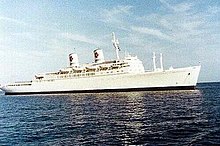
SS United States is a retired ocean liner built between 1950 and 1951 for the United States Lines. She is the largest ocean liner constructed entirely in the United States and the fastest ocean liner to cross the Atlantic in either direction, retaining the Blue Riband for the highest average speed since her maiden voyage in 1952, a title she still holds. She was designed by American naval architect William Francis Gibbs and could be converted into a troopship if required by the Navy in time of war. United States maintained an uninterrupted schedule of transatlantic passenger service until 1969 and was never used for military applications.

SS France was a Compagnie Générale Transatlantique ocean liner, constructed by the Chantiers de l'Atlantique shipyard at Saint-Nazaire, France, and put into service in February 1962. At the time of her construction in 1960, the 316 m (1,037 ft) vessel was the longest passenger ship ever built, a record that remained unchallenged until the construction of the 345 m (1,132 ft) RMS Queen Mary 2 in 2004.

SS American Victory is a Victory ship which saw brief service in the Pacific Theater of Operations during the final months of World War II, the Korean War from 1951–1954, and the Vietnam War from 1966–1969. Built in June 1945, she carried ammunition and other cargo from Los Angeles to Southeast Asia, then ferried cargo, equipment and troops back to the U.S. after the war ended. She survived two typhoons and one hurricane.

American Export-Isbrandtsen Lines, New York, was the leading US-flag shipping company between the U.S. east coast and the Mediterranean from 1919 to 1977, offering both cargo ship and passenger ship services, until it declared bankruptcy and was acquired by Farrell Lines of New York.

MS Pride of America is a cruise ship operated by NCL America, a division of Norwegian Cruise Lines, to sail itineraries in the Hawaiian Islands. Construction of the ship began in 2000 in the United States as part of a plan for a US-built and US-flagged cruise ship under Project America, but the project failed and she was eventually purchased by Norwegian Cruise Lines and completed in Germany. She was inaugurated in 2005, and was the first new U.S. flagged, deep water cruise ship in nearly fifty years since the SS Argentina of 1958.

SS Arcadia was a passenger liner built for P&O in 1953 to service the UK to Australia route. Towards the end of her life she operated as a cruise ship, based in Sydney, until scrapped in 1979.

SS Independence was an American built passenger liner, which entered service in February 1951 for American Export Lines. Originally, she plied a New York-Mediterranean route, specializing in a high-end clientele, sailing one way while her sister ship, SS Constitution, plied the route the opposite. Starting in 1980 she sailed as a cruise ship. She was shortly joined by her similarly graceful counter sterned sibling, the pair sharing the Hawaiian islands together for the better part of two decades until their retirements.

RMS Sylvania was an ocean liner built in 1957 by John Brown & Co (Clydebank), in Glasgow, for the United Kingdom-based shipping company Cunard Line. She was the last Cunard Line vessel built specifically for transatlantic crossings. The ship was later heavily rebuilt as a cruise ship, and sailed under the names SS Fairwind, SS Sitmar Fairwind, SS Dawn Princess and SS Albatros before being scrapped in 2004. She was renamed SS Genoa for her last voyage.
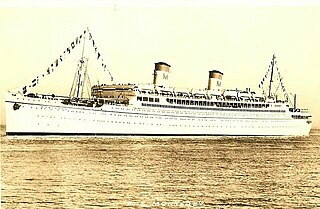
SS Monterey was a luxury ocean liner launched on 10 October 1931. The ship was completed April 1932 and is shown in registers as a 1932 ship. Monterey was the third of the four ships of the Matson Lines "White Fleet", which were designed by William Francis Gibbs and also included SS Malolo, SS Mariposa and SS Lurline. Monterey was identical to Mariposa and very similar to Lurline. During World War II Monterey was used as a troopship operated by Matson as agents of the War Shipping Administration (WSA). Monterey was a large, fast transport capable of sailing independently and was allocated to serving Army troop transport requirements. The ship was involved in an attack on a convoy near Cape Bougaroun.
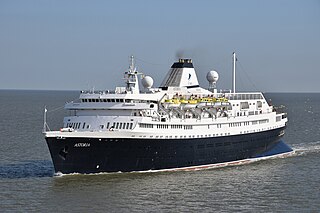
MV Astoria is a ship that was constructed as the transatlantic ocean liner Stockholm for Swedish American Line, and rebuilt as a cruise ship in 1993. Ordered in 1944, and commenced service in 1948, at 76 years old, she is the oldest deep water passenger liner still around in a non retired status. As Stockholm, she was best known for an accidental collision with Andrea Doria in July 1956, resulting in the sinking of the latter ship and 46 fatalities off the coast of Nantucket, Massachusetts, United States.

USS Aeolus (ID-3005), sometimes also spelled Æolus, was a United States Navy troopship in World War I. She was formerly the North German Lloyd liner Grosser Kurfürst, also spelled Großer Kurfürst, launched in 1899 that sailed regularly between Bremen and New York. At the outset of World War I the ship was interned by the United States and, when the US entered the war in 1917, was seized and converted to a troop transport.
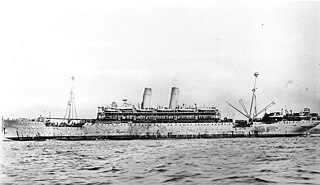
USS Princess Matoika (ID-2290) was a transport ship for the United States Navy during World War I. Before the war, she was a Barbarossa-class ocean liner that sailed as SS Kiautschou for the Hamburg America Line and as SS Princess Alice for North German Lloyd. After the war she served as the United States Army transport ship USAT Princess Matoika. In post-war civilian service she was SS Princess Matoika until 1922, SS President Arthur until 1927, and SS City of Honolulu until she was scrapped in 1933.

RMS Orion was an ocean liner launched by the Orient Steam Navigation Company in 1934 and retired from the water in 1963 after carrying about 500,000 passengers. A 23,371 ton passenger ship, the Orion was built to carry 486 first class, 653 tourist class passengers and 466 crew from Europe through the Pacific to Australia. The construction of the ship was documented in Paul Rotha's 1935 film Shipyard.

SS Orsova, was a British ocean liner, built by Vickers Armstrong in Barrow-in-Furness, England, for the Orient Steam Navigation Company for their Great Britain-to-Australia services via the Suez Canal. She was the final development of the 28,000 ton class which began with the SS Orcades of 1948 and continued with the SS Oronsay of 1951. In 1960, in conjunction with the introduction of the new larger and faster Oriana and Canberra, the fleets of Orient and P&O were combined as P&O-Orient Lines, although the Orient ships retained their corn-coloured hulls and sailed under their own house flag. In 1966, P&O acquired the balance of the Orient shares and the Orient Line was discontinued, with Orsova and her fleet mates being transferred to the ownership of the Peninsular & Oriental Steam Navigation Company (P&O), painted white and under the P&O houseflag.
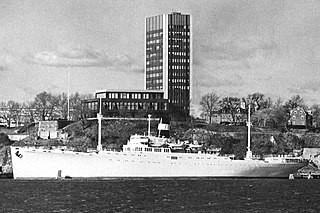
SS Stevens, a 473-foot (144 m), 14,893-ton ship, served as a floating dormitory from 1968 to 1975 for about 150 students of Stevens Institute of Technology, a technological university, in Hoboken, New Jersey. Permanently moored on the scenic Hudson River at the foot of the campus across from New York City, this first collegiate floating dormitory became one of the best-known college landmarks in the country.

SS Exochorda was a 473-foot, 14,500-ton cargo liner in service with American Export Lines from 1948 to 1959. A member of the line's post-war quartet of ships, "4 Aces", Exochorda sailed regularly from New York on a Mediterranean route. Originally built in 1944 as the military attack transport USS Dauphin (APA-97), the ship was extensively refurbished prior to her service as a passenger-cargo liner. Following her service as a cruise liner, the vessel served as the floating dormitory ship SS Stevens for the students of Stevens Institute of Technology, a technological university, in Hoboken, NJ. At the end of her service life she was scrapped, in 1979.

RMS Carinthia was an ocean liner built in 1956 as one of the four Saxonia class ships. She sailed for Cunard Line from her completion until 1968 when she was sold to Sitmar Line, rebuilt into a full-time cruise ship and renamed SS Fairsea. She sailed with Sitmar until 1988, when Sitmar was sold to P&O. She was renamed SS Fair Princess and sailed for Princess Cruises and P&O Cruises until 2000. She was then sold to China Sea Cruises and renamed SS China Sea Discovery. In 2005 or 2006 she was scrapped in Alang, India.
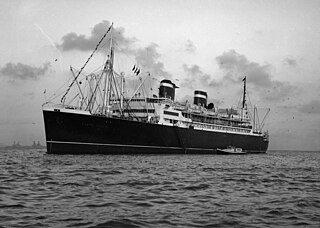
SS Santa Paula was a passenger and cargo ocean liner built for the Grace Line. She was the second of four sister ships ordered in 1930 from the Federal Shipbuilding and Drydock Company of Kearny, NJ. Her regular service route included inter-coastal service between the east coast and the west coast of the US via the Caribbean and the Panama Canal. She later sailed on cruises from New York to the Caribbean and South America. She was the second of three vessels to bear the name Santa Paula for Grace Line service.

SS Atlantic was an American-built vessel that operated for 42 years in various capacities. First designated SS Badger Mariner, she was originally built as a freighter in 1953. However, her career as a cargo vessel was relatively short. In 1958, she was rebuilt as a passenger liner. Renamed SS Atlantic, this ship became familiar to many American tourists during the 1960s, making cruises to the Caribbean and Mediterranean.


